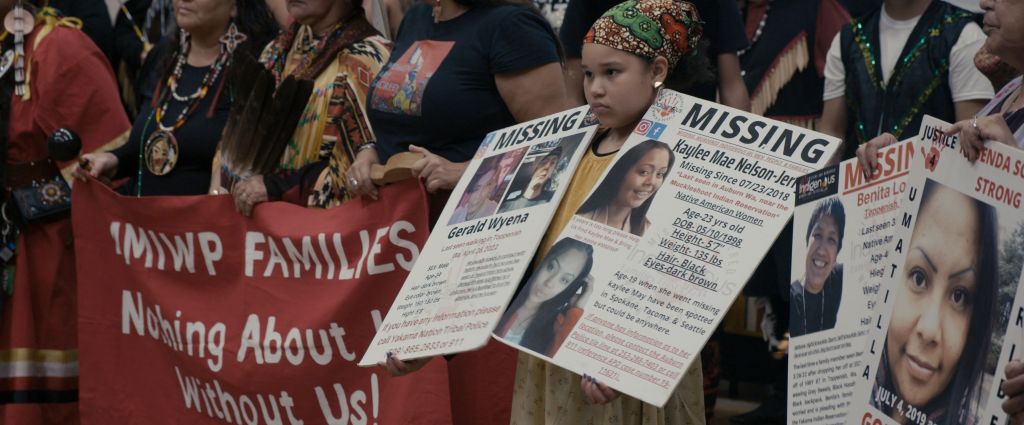At the end of 2020, Mary Ellen Johnson-Davis, a resident of the Tulalip Indian reservation outside Seattle, vanished in plain sight. Her husband, a white man with whom she had reportedly been experiencing some marital issues, reported her disappearance to the authorities and then washed his hands of the matter. Officially, the investigation is at a standstill, but Mary Ellen’s sisters Nona and Gerry, cousin Lynette, and other members of their tribe have never stopping looking for her.
The cold open to Sabrina Van Tassel’s documentary Missing From Fire Trail Road drops in on an intimate scene from the search for Mary Ellen, as her sisters point out the road where she was last seen, trying to determine if any of the homes bordering the street have cameras. “Someone knows something,” one of them ominously intones. The landscape is draped in that grey, Pacific Northwest dreariness; the scenes in and around the Tulalip reservation that cinematographer Christophe Astruc captures of serene bodies of water framed by distant mountains and desolate roads and posters on fences and buildings adorned with the faces of missing women are chilly on their own, and downright haunting when accompanied by the score, co-composed by Christophe La Pinta and Antone George. But Van Tassel and her crew accomplish this tone without edging too close to true crime sensationalism; they have too much respect for their subjects for that, and an agenda that reaches beyond tracking the investigation into Mary Ellen’s disappearance.

Sadly, the disappearance of a Native woman like Mary Ellen is not an uncommon occurrence, not only on the Tulalip reservation, but on Indian reservations across the United States. The statistics thrown out throughout the film are staggering: three out of five Native women are sexually abused, a number that in some tribes approaches 100%. Jurisdiction on reservations is complex, and so-called lawless zones where tribal police officers don’t have authority over non-Native people regardless of the level of crime they commit only exacerbates the problem. In what is essentially a continuation of the colonialism initially enacted by white Americans on Native peoples hundreds of years ago, hundreds of cases involving missing Indigenous women remain unsolved and unprosecuted.
Van Tassel calls on experts to convey the enormity of the problem. Deborah Parker, the former vice chairwoman of the Tulalip tribes and the activist who successfully campaigned for Native women to be included in the Violence Against Women Act and who also serves as an executive producer on Missing From Fire Trail Road, is a prominent voice in the film, as is Roxanne White, the executive director of Missing, Murdered Indigenous Women, People, and Families and People,” dedicated to helping families locate their missing loved ones. Alternating between formal interview settings and depicting these activists in action, the film is able to convey an enormous amount of complex, yet vital, information in a concise, clear, and compelling manner.

But what really makes the film so successful is its ability to use one family’s experience as an entry point into excavating America’s long-standing abuse of Native Americans. Van Tassel reaches all the way back to the American Indian boarding schools established soon after white settlers arrived in America and continuing to operate well into the 19th century, their mission to assimilate and Christianize Indigenous peoples resulting in Native children being forced from their homes, abused for such behavior as speaking in their native language, and often dying. The firsthand recollections from the descendants of those who were subject to this devastating effort to erase their culture, accompanied by shots of gravestones whose dates indicate children who passed away before their lived ever truly began, punches straight at the heart of America’s original sin, and the damaging depths whose details remain largely unknown to the general public to this day. It’s a vicious cycle that continues to plague Native families to this day; Gerry and Nona recount how their mother fell prey to substance abuse after her children were taken away from her and put into foster care by CPS, and how the sexual abuse they experienced as children at the hands of their foster families led to Mary Ellen venturing down the same dangerous path. By tying general history to family histories, Van Tassel never loses sight of the people at the heart of this story: the faces of Mary Ellen and other missing women on posters, and of their loved ones pressing for action, are a constant emotional through-line in the film, a visible, tangible reminder of everything that’s at stake, and everything that could be lost the longer those with the authority to do something fail to act. Van Tassel is no stranger to using documentary film as a medium for social change; her 2020 film The State of Texas vs. Melissa raised awareness of the case of Melissa Lucio, a Texas inmate on death row whose sentence was ultimately commuted. By zooming in on specifics and then zooming out, placing Mary Ellen and her family within a larger context, Missing From Fire Trail Road is not only a compelling document, but an urgent argument for systemic change.
Missing From Fire Trail Road had its world premiere at the 2024 Tribeca Film Festival on June 8. Runtime: 101 minutes.